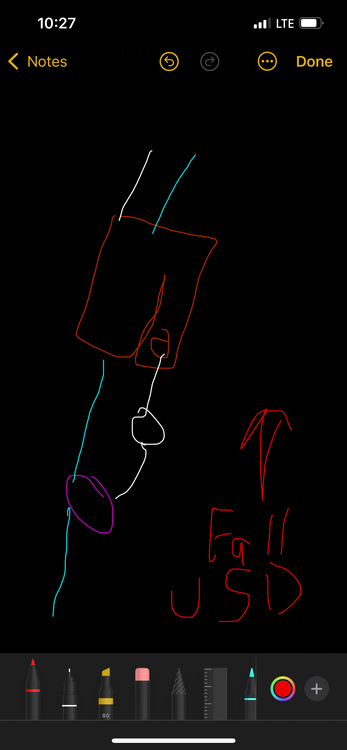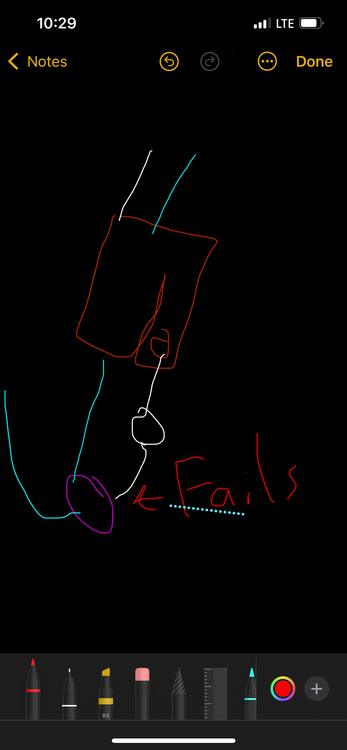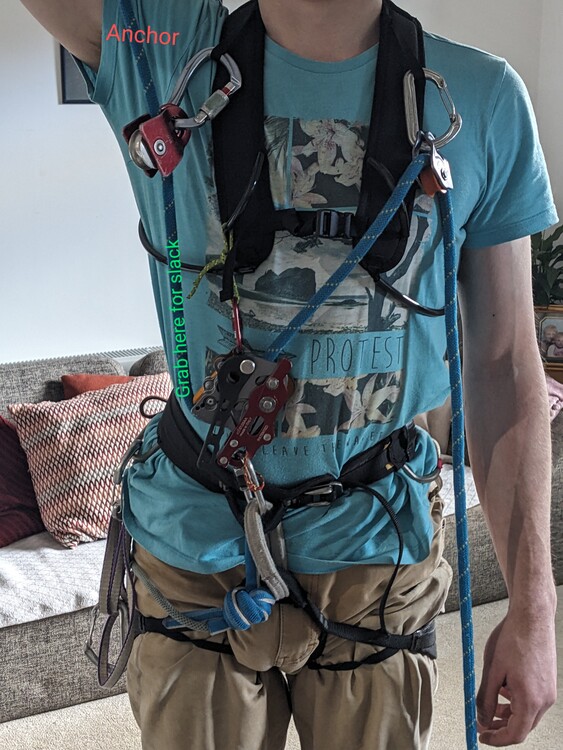The unofficial LRS Sulu Go thread
|
|
So here's how I see it, this device gives literally 0 mechanical advantage if it fails to engage there is basically no friction with the rope going straight through those jaws, the device is basically on or off. If the device is off (as in it has failed to engage), the backup will have to take the full force of the fall, which with the redirect and cache loop on the dead end I think would be quite the disaster in a fall, so it makes more sense for it to just go on the live side. The device seems to function by using some preloaded hinge and a scissor mechanism to amplify the forces into the jaw, in a regular fall the rope continues to force the device open (not by much mind you) causing additional clamping, I don't see how holding the break strand would change this, what could change this would be changing the angle of the device but that's distinct. Interestingly in the way we rig our devices for LRS, we are already opening out that hinge and clamping the rope. I think this may preload the rope enough that no matter the fall, it will always engage and prevent the straight through failure mode in a upside down fall (but that's just a thought). I'm going to play around with an elastic redirect for the live end of the rope, and see how that goes. |
|
|
Mine arrives tomorrow and I look forward to helping contribute to testing. You guys that have been contributing all this info already are doing the lord's work - appreciate you all! |
|
|
Mr Rogers wrote: What you’re missing is that the sulu cannot engage if the backup is on the live end because the rope would be forced to run through the sulu straight-thru. It would be akin to holding the sulu vertically when belaying. Review these very sloppy sketches. Do you see the issue? Fhe backup would need to be a velocity device; either a revo or fuse or asap. The revo and fuse don’t work in terms of orientation to be on the live end anyway. |
|
|
Love a high quality technical sketch! Fine work there. Edit for below from Jared:
Plausible indeed. |
|
|
Regarding the backup conversation https://youtube.com/shorts/FF-GBh9TM0A?si=qzDkHoqpINGMcEY8 I think this method should create a constant bend in a fixed but flexible place and will guarantee engagement even in the event of a worst case scenario inverted fall with the straight through failure mode. I think this could be applied to some sort of backup as well, just use a sling of some sort to attach it to your belay loop. To Mr Rogers(great job on the single take), I agree with everything in your video, what I think I wasn't clear with was the device failure mode I see is the inverted fall straight through failure mode that I'm really trying to protect against. In general use I'm happy to trust the device, I'm sure many wouldn't be but I'm happy with and accept that level of risk. I'll try out this new redirect in the field and see how I get on. |
|
|
that guy named seb wrote: Interesting idea. |
|
|
Seems like my Taz setup could be very easily implemented by just swapping out the Taz for the Sulu, yes? The Revo is on the dead rope side high up on a chest harness and if it engages it will load my Petzl Ring Open which is through my hard points via a sling. Should work real good, ja? |
|
|
Ricky Harline wrote: Maybe if on a long enough sling. |
|
|
Mr Rogers wrote: I don't see what you're trying to achieve here. Are you worried about the Sulu not engaging in a regular fall? IME it's very eager to engage (more so than a LOV, but maybe less than El Mudo) and I have minimal concerns about that. My big concern is an USD fall, which your video doesn't address at all. that guy named seb wrote: How does this help with the USD fall failure? Your video shows you pulling the rope downward (which would be upward in a USD fall) and it pulls right through with no device engagement. A USD fall would be the same, but more forceful. Ricky Harline wrote: Yes, I set up my Sulu in the same way as the LOV. The only thing that needs to change is the length of your chest harness tether. In an USD fall does your Revo not pull on the chest harness? What about when it slams into the main device? |
|
|
You know a back up knot on a locker solves the YSD fall problem. Low tech solution for the high tech device |
|
|
evan freeman wrote: In an upside down fall the sling that attaches the Revo to my Ring Open engages before the chest harness loads. Perhaps some load will go to the chest harness, but not most of it. As I'm a tall ass motherfucker and my Revo sits very high on my chest rig, it's not clear that my Revo will slam into the primary device. But if it does the Revo can't disengage. There are those two flippy thingies one of which will pop out when the Revo engages, and one of those flippy thingies will indeed make contact with the primary device in case of a collision. However, the flippy thingy that actually will open will be the opposite one to the one that potentially could slam into the primary device, so there is no risk of the Revo disengaging. I tested this on my invert fall tester 2x4 to make sure I was right about that. Perhaps the Revo could get slightly damaged, but I don't plan on taking many inverted falls. I don't think it's super likely I would damage my Revo, but if I did and had to replace it that wouldn't seem like a big problem to me for saving my life and all. |
|
|
Jabroni McChufferson wrote: Once you go knot free there's no going back. It's a dramatic improvement to your quality of life as a rope soloist and makes for dramatically less on route faff and shenanigans. I'm convinced that many people who try LRS and hate it would actually enjoy it if they didn't use systems that require so much extra work while on lead. A great many popular LRS systems require dramatically more time fucking around with the rope than say my system or the Brent Barghan method as two very different examples that both achieve very high levels of efficiency and reduce rope management fuckery to a minimum. |
|
|
Jabroni McChufferson wrote: Of course! I use and love knots as a backup. My personal method is to tie slipknots periodically on the dead end behind the MT cache manager which hangs from my belay loop (yes, I know they will get sucked into the MT and possibly damage it, but that's a risk I'm willing to take in the unlikely event of an USD fall). Like Ricky, I'm ok with an expensive piece of equipment sacrificing itself to save me. It does seem like people are still searching for the Holy Grail of a device backup, so when ideas are proposed for that I think they are worth discussing. One day something will come along that will allow smooth progress with no pausing to deal with knots. |
|
|
evan freeman wrote: I was not attacking the inverted issue when making that response to Sebs earlier post. I think I didn't understand completely what Seb was getting after so response was around presumption that he talking about just the general function of the device if it were to be defeated and a backup engaged. Would it toggle the sulu to engage the rope even though something might be actively defeating the device? Thats what my little soap box moment was addressing. I think the video still shows something worth considering around function. |
|
|
Yeah yeah yeah. A clove hitch is incredibly non faff to do one handed on a locker… if you know what your doing ;) isn’t that what Brent Barghan does, clove hitches? I appreciate the nerding out for other gear nerds like my self. |
|
|
I was thinking about the redirect in bed last night (I think if I'm not careful my girlfriend will hide it) and I realised that you don't need elastic for the redirect at all. Using a pulley to create that constant V should make the straight through failure mode impossible and protect from inverted falls. You just have to grab under the redirect for slack, and let the weight of the rope feed it up through the pulley. The only issue with this now is it doesn't autofeed. |
|
|
that guy named seb wrote: Uhhh that is indeed an issue @ jabroni: Brent uses loose cloves on snagless, non locking carabiners that can easily be removed one handed. Really not comparable to a traditional backup in terms of speed and efficiency. |
|
|
Ricky Harline wrote:
|
|
|
Ricky Harline wrote: It functions more like a cache loop that requires more attention, I always assume when soloing with a grigri that I'm likely to fall the length of my cache loop. I probably wouldn't use it free climbing, I think it's resistant enough to an upside down fall that it's worth it. Aid on the other hand, I might have gear on my chest harness raising my centre of gravity and making an invert more likely, I'll also have feet in loops that increase the risk of an inversion. I'm moving slow enough on aid that attending the loop is no big deal. |
|
|
Ricky Harline wrote: You really make tying/ untying clove hitches sound like calculus. Lots of lockers are snagless...
|

 Continue with onX Maps
Continue with onX Maps Sign in with Facebook
Sign in with Facebook
























